Field Programmable Gate Array (FPGA) Market Size, Share & Industry Trends Analysis Report by Configuration (Low-end FPGA, Mid-range FPGA, High-end FPGA), Technology (SRAM, Flash, Antifuse), Node Size (=16 nm, 20-90 nm, >90 nm), Vertical (Telecommunications, Data Center & Computing, Automotive) & Region - Global Forecast to 2029
Updated on : Oct 22, 2024
FPGA Market Size & Growth
The Field Programmable Gate Array (FPGA) Market size was valued at USD 12.1 billion in 2024 and is projected to reach USD 25.8 billion by 2029, growing a CAGR of 16.4% during the forecast period from 2024 to 2029.
Rising integration of FPGAs in advanced driver assistance systems for hardware acceleration and real-time processing, as well as growing integration in data centers and high-performance computing applications, are driving the growth of the FPGA market. Also, the ongoing rollout of 5G Technology has accelerated the adoption of FPGA to implement software-defined networking (SDN).
FPGAs offer high flexibility in dynamic network configuration and contribute to the scalable and efficient deployment of 5G infrastructure. However, the lack of standardized FPGA verification and validation techniques restrains the growth opportunities for FPGA players.
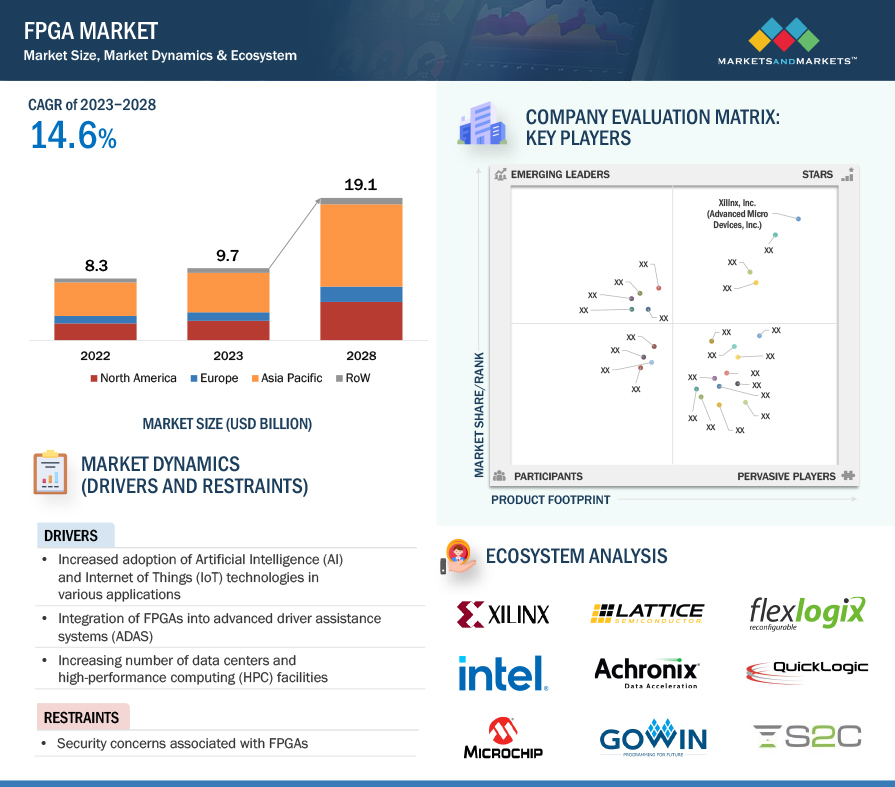
FPGA Market Statistics Forecast to 2029
To know about the assumptions considered for the study, Request for Free Sample Report
Field Programmable Gate Array (FPGA) Market Trends
Drivers: Increasing adoption of artificial intelligence (AI) and Internet of Things (IoT) technologies in various applications
Increasing adoption of Al and IoT across wide range of industries has transformed applications involving intricate motor control and vision processing. These tasks have accelerated the demand for advanced computing capabilities and real-time, deterministic system behaviour, propelling the adoption of FPGA due to their inherent hard-deterministic features.
The convergence of Al and IoT technology has boosted the development of innovative business models, encouraging significant technological advancements in the FPGA field. FPGAS play a crucial role in driving innovations in intelligent buildings, connected vehicles, smart power grids and urban infrastructure.
According to GSM Association report in 2023, the licensed cellular IoT connections are estimated to double and can reach to 5.3 billion by 2030, where Greater China contributing to two-thirds of the total connections. This significant growth in global IOT connections will propel the growth opportunities for FPGA industry.
Key industry players for FPGA including Xilinx, Inc. (Advanced Micro Devices, Inc.) (US), Intel Corporation (US), and Lattice Semiconductor Corporation (US), are also inclined towards accelerating their FPGA offerings in the field of Al and IoT, incorporating both hardware and software programmability.
Restraint: Security concerns associated with FPGAs.
?Side-channel attacks (SCAs) constitute a completely unique class of threats manipulating physical characteristics in cryptographic gadgets, including FPGAs, to extract sensitive information. Unlike traditional cryptographic attacks, SCAs focus at the physical implementation of algorithms, using variations in power consumption, electromagnetic radiation (EMR), and timing.
FPGAs are thereby susceptible to SCAS owing to their inherent physical properties that are challenging to control. Two primary sorts of SCAs include simple side-channel evaluation (SSCA) and more effective differential aspect-channel analysis (DSCA).
To overcome these challenges manufacturers are adoption various strategies for FPGAs such as covering, shielding, randomization, secure design practices, and continuous monitoring. However, these measures cannot completely eliminate the evolving threat of SCAs. Ongoing research is essential for the development of new countermeasures for enhanced FPGA protection.
Opportunities: Surging deployment of 5G communique infrastructure
The evolution of 5G network infrastructures creates a substantial growth opportunity in the FPGA market. Development of 5G New Radio (NR) as the new air interface for 5G networks is redesigning the landscape for telecom infrastructure.
Present 5G architectures incorporates NR radio heads in base stations, which includes massive multiple-input, multiple-output (MIMO) antennas integrating multiple transmitters and receivers for fast data transfer. This robust infrastructure offers distinct access and connectivity settings, together with improved mobile broadband (EMBB), massive machine-type communications (mMIC), and ultra-dependable low-latency communications (URLLC).
To meet the growing demands of 5G network workloads, there is a rising inclination towards FPGA technology to accelerate the expansion of next-generation wireless infrastructure. This trend implies a stimulating opportunity for market players in the FPGA industry.
Challenge: Lack of improved and standardized verification techniques
The lack of standardization in the FPGA industry has created several challenges for FPGA designers and users. The FPGA designers have to bear with the complexities of multiple FPGA architectures and toolchains, which results in increasing design time and complexities.
The lack of standardization has further restricted the portability among FPGA designs, which increase the challenges in reusing and reconfiguring FPGA designs across various platforms. Continuous advancement in FPGA technology has also raises the challenges along with the lack of standardization.
The continuous expansion of new architectures and features have further imposed pressure on FPGA designers to adapt new design methodologies. This continuous evolution has restrained the adoption of new FPGA technologies, as designers may be uncertain to invest in training and tool updates.
FPGA market Map:
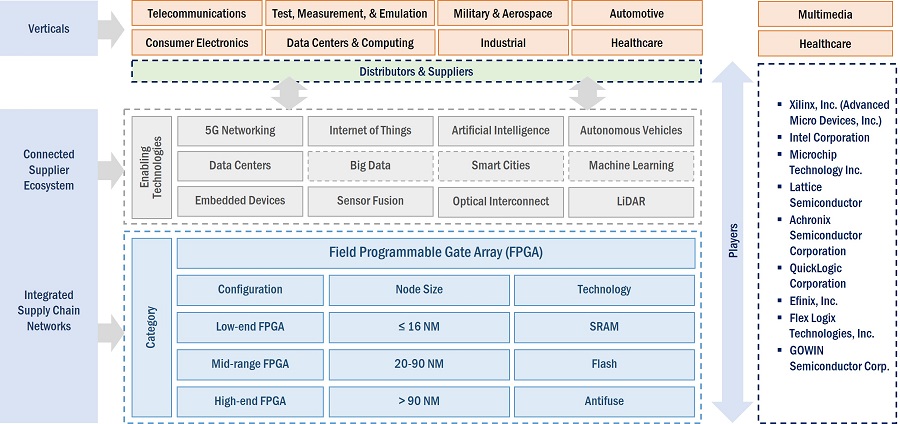
FPGA Market Segmentation
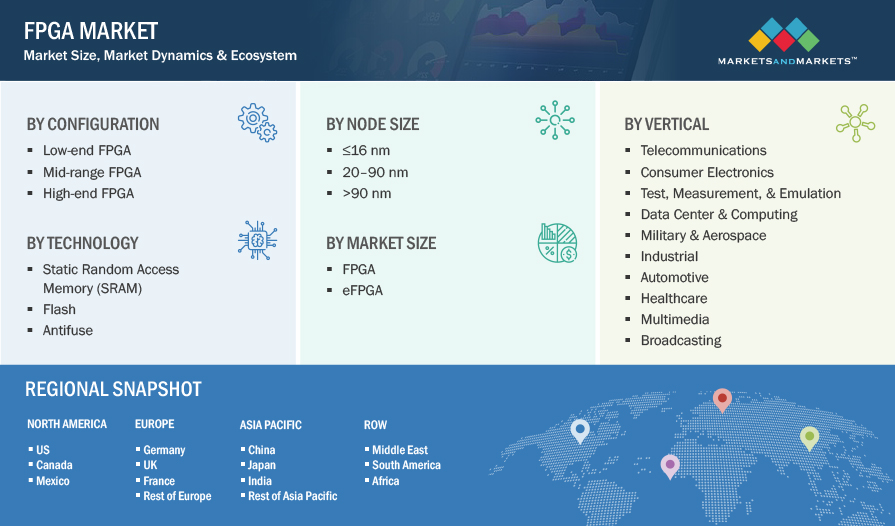
The market for high-end FPGA segment to hold highest CAGR during the forecast period.
High-end FPGAs are characterized on the basis of cutting-edge features, broad resources, and high-performance capabilities. High-end FPGA includes large number of logic elements, improved memory capacity, and wide selection of advanced functionalities.
These high-end FPGAs are majorly adopted for applications such as high-performance computing, telecommunication infrastructure, data centers, and aerospace & defense. High-end FPGAs aims to deliver high flexibility and allows the integration of complex digital circuits and algorithms for these computationally intensive applications.
Although, these high-end FPGAs are majorly offered at higher cost, as compared to other low-end FPGAs. Nevertheless, these FPGAs delivers unparalleled processing power and improved flexibility which makes them indispensable for cutting-edge and mission-critical applications.
20-90 nm segment in node size to hold the highest market share of the Field Programmable Gate Array (FPGA) market during the forecast period.
FPGAs with 20-90 nm node size aims to deliver high durability and low power consumption, which make them as optimal solutions for digital signal processing (DSP) applications.
These FPGAs are featured with high density, increased memory capabilities, integrated multipliers, and easy packaging, which increase their adoption across a wide range of industries. They play integral roles in industrial networks, vehicle networking, high-resolution videos, graphics, 10 to 100G networking, portable radars, ASIC prototyping, 3G/4G/5G wireless connectivity, flat-panel displays, video over Internet protocol (IP) solutions, software-defined radios (SDRs), machine vision cameras, low-end wireless backhaul, any-to-any connectivity, sensor fusion, and embedded vision applications.
The major FPGA manufacturers are also inclined towards the development of FPGAs with 20-90 nm node size, to cater increasing demand from end use industries. This emphasizes the adoption of these 20-90 nm node size FPGAs in addressing the developing needs among data center and telecom applications and supports the dynamic landscape of the FPGA market.
SRAM segment in technology to the highest market share of the Field Programmable Gate Array (FPGA) during the forecast period
SRAM's plays a major role in improving the speed and efficiency of FPGAs and aids to deliver quick access times. The FPGAs are integrated in wide range of industries including telecommunications, automotive, and military & aerospace, and there SRAM's flexibility has become a major factor in meeting the various demands of these sectors. Integration of SRAM into FPGAs establishes as the cornerstone for the market's growth, by catering to the evolving needs of industries which relies on FPGA technology.
SRAM technology aids to deliver easy reconfiguration based on specific application needs, which increases their adoption among FPGA payers. SRAM-based FPGAs enables logic implementation through look-up tables (LUT) and embedded RAM blocks, which further helps in testing new FPGA designs beside existing standards. Their global popularity stems from the ease of control, routing, and configuring switches.
Data-center and computing segment to account for largest CAGR of the FPGA market during the forecast period.
Rise in data center adoption has created substantial opportunities for the FPGA market. Increasing data processing capabilities in data center has accelerated the demand for FPGAs for high-performance capabilities and are pivotal for accelerating tasks such as machine learning and artificial intelligence.
Increasing demand for real-time processing in applications such as financial trading creates significant opportunities for FPGAs to deliver low latency and real-time computational ability, accelerating their growth opportunities in data center infrastructure.
The data center applications increasingly prioritize hardware acceleration, network function virtualization, edge computing, security improvements, and cost optimisation, which creates significant opportunities for FPGAs players to strengthen their position among data-driven applications.
The Field Programmable Gate Array (FPGA) in the Asia Pacific is estimated to grow at a higher CAGR during the forecast period.
Growing number of data centers in Asia Pacific has accelerated the market potential for FPGA players in the region. The growth is majorly driven by the rising demand for high-performance computing, data processing, and effective networking solutions among data center infrastructures.
FPGAs are efficient in handling complex tasks which increase their adoption among the dynamic and advanced requirements of modern data centers. Major players in the region are majorly inclined and are continuously investing towards new strategic initiatives in the field of data center infrastructure, which further upsurge the demand for FPGA.
The Asia Pacific market is experiencing high growth opportunities with the growing demand for high-speed broadband services and mobile devices, particularly among China and India. Furthermore, the projected and continuous expansion of telecommunication and data center networking infrastructure is expected to propel the FPGA market in the Asia Pacific region.
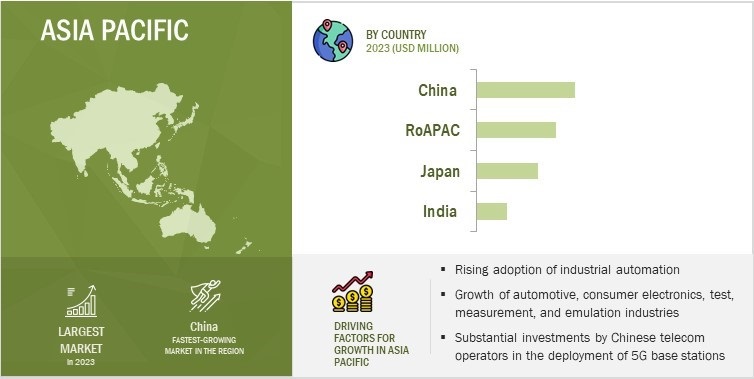
FPGA Market Statistics by Region
To know about the assumptions considered for the study, download the pdf brochure
Top Field Programmable Gate Array (FPGA) Companies - Key Market Players
Major vendors in the FPGA market include
- Advanced Micro Devices, Inc. (Formerly Xilinx, Inc.) (US),
- Intel Corporation (US),
- Microchip Technology Inc., (US),
- Lattice Semiconductor Corporation (US),
- Achronix Semiconductor Corporation (US),
- QuickLogic Corporation (US),
- Efinix, Inc. (US), FlexLogix (US),
- GOWIN Semiconductor Corporation (China), and S2C (China).
- Apart from this, AGM Micro (China), Shanghai Anlu Information Technology Co., Ltd. (China), Shenzhen Ziguang Tongchuang Electronics Co., Ltd. (China), Xi'an Zhiduoji Microelectronics Co., Ltd. (China), Renesas Electronics Corporation (Japan), LeafLabs, LLC (US), Aldec, Inc. (US), ByteSnap Design (UK), Enclustra (Switzerland), EnSilica (UK), Gidel (US), Nuvation Engineering (US), EmuPro Consulting Private Limited (India), iWave Systems Technologies Pvt. Ltd. (India), and Mistral Solutions Pvt. Ltd (India) is among a few emerging companies in the FPGA market.
FPGA Market Report Scope
|
Report Metric |
Details |
| Estimated Market Size | USD 12.1 billion in 2024 |
| Projected Market Size | USD 25.8 billion by 2029 |
| FPGA Market Growth Rate | CAGR of 16.4% |
|
Market size available for years |
2020—2029 |
|
Base year |
2023 |
|
Forecast period |
2024—2029 |
|
Segments covered |
Configuration, Node-Size, Technology, FPGA and eFPGA market size, Vertical, and Region |
|
Geographic regions covered |
North America, Europe, Asia Pacific, and RoW |
|
Companies covered |
The major players include Advanced Micro Devices, Inc. (Formerly Xilinx, Inc.) (US), Intel Corporation (US), Microchip Technology Inc., (US), Lattice Semiconductor Corporation (US), Achronix Semiconductor Corporation (US), QuickLogic Corporation (US), Efinix, Inc. (US), |
FPGA Market Highlights
This research report categorizes the FPGA market based on Configuration, Node Size, Technology, FPGA and eFPGA market size, Vertical, and Region
|
Segment |
Subsegment |
|
By Configuration: |
|
|
By Node-Size: |
|
| By Technology: |
|
|
By Size: |
|
| By Vertical: |
|
|
By Region: |
|
Recent Developments in FPGA Industry
- In December 2023, Lattice Semiconductor (US) has announced the launch of “Lattice CrossLinkU-NX FPGA family”, with integrated USB device functionality “Lattice CrossLinkU-NX FPGA family”. These FPGAs helps to enhance USB-equipped system designs, deliver reference design and upgrade thermal management. Lattice has simplified the USB-based design to support the growing demand among AI related applications and increase their market potential among wide range of end-use industries including Computing, Industrial, Automotive, and Consumer electronics.
- In June 2023, Intel Corporation (US) has announced its partnership with Taiwan Semiconductor Manufacturing Company Limited (TSMC) (Taiwan). TSMC is engaged in providing products for various applications including high-performance computing and smartphones. The partnership will include the manufacturing of chips for Intel’s high-performance computing and graphics products and will helps Intel to reduce its reliance on external foundries.
- In June 2023, Microchip Technology Inc. (US) announced the launch of the industry's first mid-range industrial edge stack, ready-to-customize cryptography and boot libraries of soft intellectual property (IP), and new tools to convert current FPGA designs to PolarFire devices are all announced as new development resources and design services to help with the transition.
Key Questions Addressed in the Report:
What is the total CAGR expected to be recorded for the FPGA market during 2024-2029?
The global FPGA market is expected to record a CAGR of 16.4% from 2024-2029.
Which regions are expected to pose significant demand for the FPGA market from 2024-2029?
Asia Pacific and North America are expected to pose significant demand from 2024 to 2029. Major economies such as US, Canada, China, Japan, and India are expected to have a high potential for the future growth of the market.
What are the major market opportunities in the FPGA market?
The growing interest in FPGAs for high-bandwidth devices is on the upswing, the increasing implementation of 5G communication infrastructure is on the rise, the expanding adoption of FPGAs within the military and aerospace sector is on the upward trajectory, and the widespread establishment of data centers globally is set to drive the adoption of FPGAs are the significant market opportunities in the FPGA market during the forecast period.
Which are the significant players operating in the FPGA market?
Key players operating in the FPGA market are Advanced Micro Devices, Inc. (Formerly Xilinx, Inc.) (US), Intel Corporation (US), Microchip Technology Inc., (US), Lattice Semiconductor Corporation (US), Achronix Semiconductor Corporation (US).
What are the major verticals of the FPGA market?
Telecommunications, Consumer Electronics, Test Measurement & Emulation, Data Center & Computing, Military & Aerospace, Industrial, Automotive, Healthcare, Multimedia, and Broadcasting are the major verticals of the FPGA market.
To speak to our analyst for a discussion on the above findings, click Speak to Analyst

The research study involved the extensive use of secondary sources, directories, and databases (annual reports or presentations of companies, industry association publications, directories, technical handbooks, World Economic Outlook (WEO), trade websites, Hoovers, Bloomberg Businessweek, Factiva, and OneSource) to identify and collect information useful for this technical, market-oriented, and commercial study of the FPGA market. Primary sources mainly comprise several experts from the core and related industries, along with preferred suppliers, manufacturers, distributors, service providers, system providers, technology developers, alliances, and standards and certification organizations related to various phases of this industry’s value chain.
Secondary Research
Various secondary sources have been referred to in the secondary research process for identifying and collecting information important for this study. The secondary sources include annual reports, press releases, and investor presentations of companies; white papers; journals and certified publications; and articles from recognized authors, websites, directories, and databases. Secondary research has been conducted to obtain key information about the industry’s supply chain, market’s value chain, the total pool of key players, market segmentation according to the industry trends (to the bottom-most level), geographic markets, and key developments from both market- and technology-oriented perspectives. The secondary data has been collected and analyzed to determine the overall market size, further validated by primary research.
Primary Research
In the primary research process, various primary sources from the supply and demand sides have been interviewed to obtain qualitative and quantitative information for this report. The primary sources from the supply side include industry experts, such as CEOs, vice presidents, marketing directors, technology & innovation directors, and related key executives from key companies and organizations operating in the FPGA market across four major regions: North America, Europe, Asia Pacific, and RoW (the Middle East & Africa, South America). Primary data has been collected through questionnaires, e-mails, and telephonic interviews. Approximately 40% and 60% of primary interviews have been conducted from the demand and supply sides, respectively.
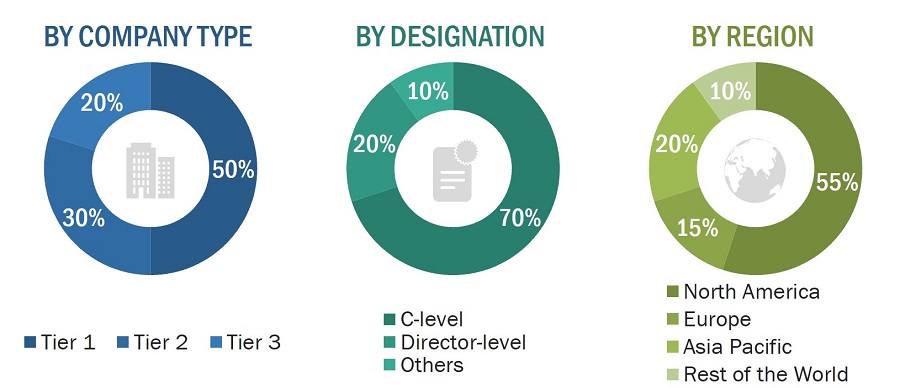
To know about the assumptions considered for the study, download the pdf brochure
Market Size Estimation
In the complete market engineering process, both top-down and bottom-up approaches have been used along with several data triangulation methods to perform market estimation and forecasting for the overall market segments and subsegments listed in this report. Key players in the market have been identified through secondary research, and their market shares in the respective regions have been determined through primary and secondary research. This entire procedure includes the study of annual and financial reports of the top market players and extensive interviews for key insights (quantitative and qualitative) with industry experts (CEOs, VPs, directors, and marketing executives).
In this approach, important players, such as Advanced Micro Devices, Inc. (Formerly Xilinx, Inc.) (US), Intel Corporation (US), Microchip Technology Inc., (US), Lattice Semiconductor Corporation (US), and Achronix Semiconductor Corporation (US) have been identified. After confirming these companies through primary interviews with industry experts, their total revenue has been estimated by referring to annual reports, SEC filings, and paid databases. Revenues of these companies pertaining to the business units (Bus) that offer FPGAs have been identified through similar sources. Industry experts have reconfirmed these revenues through primary interviews.
FPGA Market: Bottom-Up Approach

The bottom-up approach has been employed to arrive at the overall size of the FPGA market from the revenues of key players and their share in the market.
FPGA Market: Top-Down Approach

In the top-down approach, the overall market size has been used to estimate the size of the individual markets (mentioned in the market segmentation) through percentage splits from secondary and primary research. The most appropriate immediate parent market size has been used to implement the top-down approach to calculate the market size of specific segments. The top-down approach has been implemented for the data extracted from the secondary research to validate the market size obtained.
Each company’s market share has been estimated to verify the revenue shares used earlier in the supply-side approach. The overall parent market size and individual market sizes were determined and confirmed in this study by the data triangulation method and the validation of data through primaries. The data triangulation method used in this study is explained in the next section.
Data Triangulation
After arriving at the overall market size from the estimation process explained above, the overall market has been split into several segments and subsegments. The data triangulation procedure has been employed wherever applicable to complete the overall market engineering process and arrive at the exact statistics for all segments and subsegments. The data has been triangulated by studying various factors and trends from both the demand and supply sides. Additionally, the market size has been validated using top-down and bottom-up approaches.
Market Definition
Field programmable gate array (FPGA) are semiconductor devices structured with a matrix of configurable logic blocks (CLBs) interconnected through programmable pathway. FPGA have the ability to be reprogrammed post-manufacturing according to specific application need, in contrast to Application-specific integrated circuits (ASIC), which are tailored for particular design function. While one time programmable (OTP) FPGA exit, the prevalent variants are based on Static random access memory (SRAM), which can be reprogrammed as per the design requirement. These FPGA are used in a range of industries such as telecommunication, consumer electronics, military and aerospace, industrial, automotive, data center, healthcare, multimedia, and broadcasting.
Key Stakeholders
- Original equipment manufacturers (OEMs)
- Providers of technology solutions
- Research institutes
- Market research and consulting firms
- Forums, alliances, and associations related to the FPGA market
- Technology investors
- Governments and financial institutions
- Analysts and strategic business planners
- Existing end users and prospective ones
- Business providers
- Professional service/solution providers
Report Objectives
- To define, describe, and forecast the FPGA market, by configuration, node size, technology, FPGA and eFPGA market size, vertical, and region, in terms of value
- To forecast the size of the market segments for four major regions, namely, North America, Europe, Asia Pacific, and the Rest of the World (RoW)
- To provide detailed information regarding the major factors influencing the growth of the market (drivers, restraints, opportunities, and challenges)
- To provide an ecosystem analysis, case study analysis, patent analysis, technology analysis, average selling price analysis, Porter’s Five Forces analysis, and regulations pertaining to the market
- To provide a detailed overview of the value chain of the FPGA ecosystem
- To strategically analyze micro markets with respect to individual growth trends, prospects, and contributions to the total market
- To strategically profile the key players and comprehensively analyze their market shares and core competencies
- To analyze the opportunities in the market for stakeholders and describe the competitive landscape of the market
- To analyze competitive developments, such as collaborations, agreements, partnerships, and product developments in the market
- To analyze the impact of the recession on the FPGA market
Available Customizations
With the given market data, MarketsandMarkets offers customizations according to the company’s specific needs. The following customization options are available for the report:
Company Information
- Detailed analysis and profiling of additional market players (up to 7)



 Generating Response ...
Generating Response ...











Growth opportunities and latent adjacency in Field Programmable Gate Array (FPGA) Market